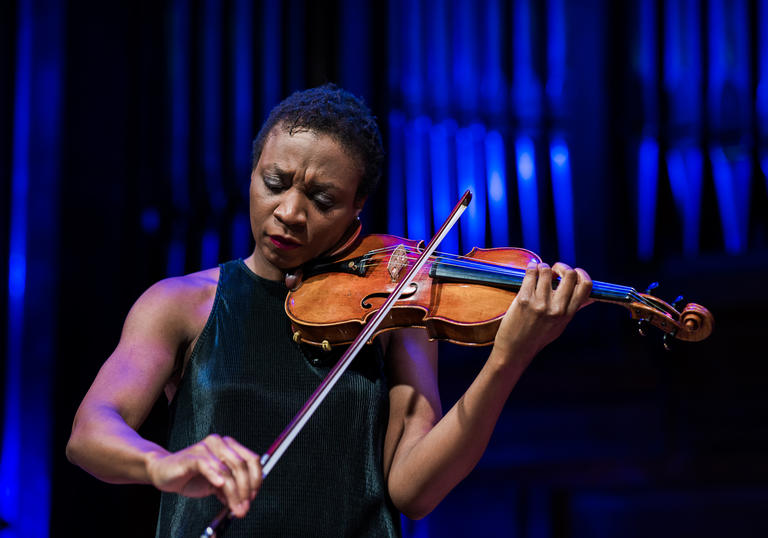According to Tai Murray, they each have a special way of playing with time in their music. She says: ‘I am fascinated by the relationship with rhythm in all four pieces. All these composers use time in a different way, demonstrating how timing is a relative concept in music. Clara Schumann has a special ability to make time fluid. All three movements of the John Adams piece play with time in different ways. Pärt’s ability to suspend time altogether is remarkable, and Schubert elongates time.’
Tonight’s recital opens with Clara Schumann’s 3 Romances, written in 1853 and dedicated to the great violinist Joseph Joachim, with whom she toured the pieces as an international star in her own right. Schumann studied composition with her father as a child prodigy and often performed her own works in recitals, her first published work written when she was only 11. She went on to create a remarkable body of work until her husband's death in 1856, but inevitably her work didn’t receive the attention it merited until relatively recently.
Murray says, ‘I’ve loved this piece ever since I started playing it. It feels very personal. There’s good-natured dialogue between the piano and the violin and Schumann has the ability to make music both speak and sing at the same time – there’s a real understanding of language in the way that she writes. She is also able to create characters and personalities within the music.’ And of course, there’s her control of timing: ‘It feels like she could fill 25 notes into three seconds and you wouldn’t even realise. She has a great understanding of what rubato is – the idea of stealing time but also somehow giving it back.’
From there, we skip 142 years to John Adams’ Road Movies and a Minimalist style that eschews Schumann’s lyricism for the repetition of cells of music. Adams often uses physical movement in his work, whether of planes or cars, and said of this piece, ‘It evokes an easy drive through an imagined landscape,’ describing the first movement: ‘It’s just like travelling – you see an object coming in the distance and the closer you drive the closer it gets, and then it passes you by and you’re on to the next idea.’
The jerk forward in musical history is intentional, Murray says: ‘As violinists, we have such a huge range of repertoire to choose from and I’m interested in changing gears and showing how two different people from two very different times understand the world in two very different ways.’ How does it feel to make such a shift as the performer? She explains: ‘There’s a different physical approach – the arms and hands come to the instrument at a different speed, in a different plane, but that’s part of the fun for me. It doesn’t feel strange to me, in the moment. It’s a matter of being convinced about what we want to say about both pieces.’
The Adams is followed by Arvo Pärt’s Passacaglia, written to be performed by contestants at the Hannover International Violin Competition in 2003, and therefore showcasing various technical challenges for the violin. Pärt’s style is also Minimalist, repeating units of music, but he developed his own ‘tintinnabulist’ form, evoking the sound of bells. The effect is quite unlike that of the Adams, says Murray: ‘They have a very different emotional impact. The Pärt brings in themes of fighting oppression and war. I’ve never experienced anything like the effect that Pärt’s music has on audiences. It leaves people speechless. I played his Spiegel im Spiegel for a group of children recently and they had their mouths open in total silence. That’s a testament to Pärt. Somehow, he reaches into something very deep and never lets go of it. It’s very emotional. The music comes from someone who is obviously a great intellectual, but it doesn’t require that you have to be intellectually engaged. You can just be with it. He has the real ability of suspending time.’
The programme closes with Schubert’s Violin Sonata in A Major, Grand Duo, written in 1817. Murray says, ‘There are some fantastic melodies and a lot of personality. It has the singing quality that we know and love about Schubert and uses the relationship between the instruments in a masterful way, yet very simply, giving it a great inner depth. It sounds effortless, but Schubert is very precise in the detail he leaves in his score, to the level of obsessive – he’s very specific in his dynamics. As players we must follow all these markings in order to create the very long arches for which he is famous for and which create the sense that time is elongated. It often feels as if his music goes on without end – in a way that feels deeply satisfied.’
Murray is looking forward to working again with Martin Roscoe, with whom she last performed in 2020. She says: ‘We get along very well. Playing together feels organic. We can speak together about music without actually speaking a lot.’
Murray herself is synesthetic, so sees music in actual colour. She explains: ‘Pitches and sounds create colour for me. A section might have a particular visual effect for me. I can’t necessarily specify what that is – it’s in the moment.’ For those who can’t naturally see music in this way, she encourages them to imagine anyway: ‘These four pieces are all very different, but something they have in common is that they can be very visual, so listeners can be imaginative in allowing these pieces to create pictures, because they do for me.’
© Ariane Todes

